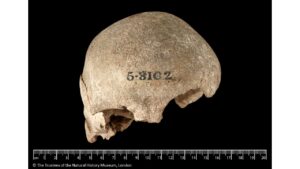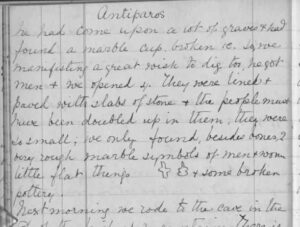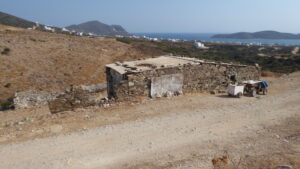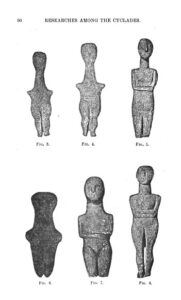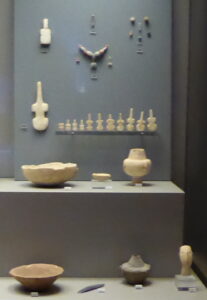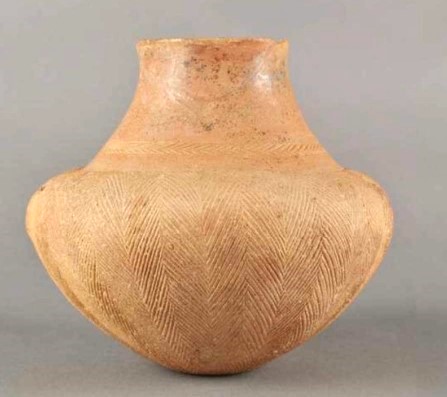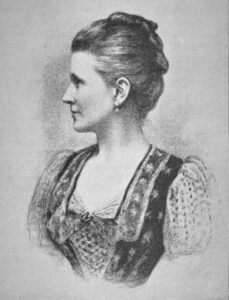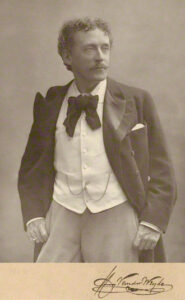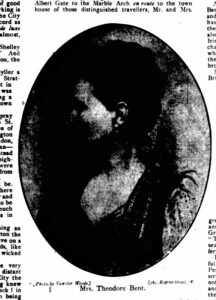
“He modelled but sparingly for bronze…” (Kineton Parkes 1921: 111)
“… one of the best of the pure sculptors of the Nineteenth Century Renaissance, a man who loved his work with all his heart and soul, and one who loved his fellow men.” (Kineton Parkes 1921: 112)
“It is certainly for his power of telling a story beautifully… that Mr. Lee will continue to be admired.” (Spielmann 1901: 66)
The commission

By the mid 1890s, Theodore and Mabel Bent had become celebrities; they had amazed London with their fifteen-year campaign of explorations and discoveries in large areas of the Eastern Mediterranean, Africa, and the Middle East, which, regularly updated in the media, had captivated a huge, international audience. Bent had produced countless articles and scholarly papers, as well as six books; the couple gave regular talks and lectures (often with lantern-slides reproduced from Mabel’s photographs) to various institutions and at popular events; the British Museum had hundreds of their acquisitions. Their personal collection in London was often on show to the public; they were sought after by editors for interviews, Mabel featuring equally with Theodore.
It is not surprising, therefore, that, as well as the couple appearing at the leading studio photographers for their portraits, Mabel should also have approached, or been approached by the innovative British sculptor and artist Thomas Stirling Lee (TSL, 1857-1916) for her relief likeness, opting for a roundel (‘medallion’) in bronze. Presumably she must have gone to TSL’s studio, in Chelsea Vale, with its small foundry en suite, to sit for him. He would have been paid for this commission certainly; at an exhibition some years later he was asking 10 guineas (c. £750 today) for medallions of idealised themes (Leeds City Art Gallery Exhibition, 1909). It is not known to date whether TSL also produced a likeness of Theodore Bent. note 1
The two bronze reliefs of Mabel Bent

The 1895 relief (confidently attributed to TSL) has (June 2024) been acquired by the friends of the Bent Archive and features above. Facing right, the sitter’s features are handsome and strong, her famous red hair coiled, her chin ready to face the travel challenges ahead, her nose a compass needle, due East; her name, Mrs J. Theodore Bent, runs boldly clockwise, with the date – 1895; the TSL monogram stands out, bottom left (the combined letters ‘TSL’ and a series (3 or 4) of knobs on the rim before the lettermark). Sculpted and cast by TSL in bronze; maximum width 26 cm; weight 1.86 kg.

The 1896 relief is today in private hands and is not illustrated here note 2 . It is essentially a reworking of the 1895 version. Again facing right, this time the features are softer, as if Mabel had requested a perhaps less assertive appearance; as if the 1895 relief were sculpted en-scène, in the intense heat of the Wadi Hadramaut, for example, while the 1896 version comes demurely from her London drawing-room at 13 Great Cumberland Place, perhaps while giving an interview, over tea and sandwiches: Mabel as Britannia. Once more, her famous red hair is coiled high, her name runs clockwise, with the date – 1896; the TSL lettermark and characteristic knobs also appear, bottom left. Sculpted and cast by TSL (dimensions and weight n/a at present).
In terms of the two dates (1895 and 1896), it is difficult, without documentation, which might appear, to give the exact times when TSL (or Mabel Bent) might have been working on the sculpting and casting the reliefs. Over these years, Theodore and Mabel were exploring east and west of the Red Sea. Mabel may have been available for the modelling in the late spring and summer, when they habitually returned to their London townhouse before undertaking family visits to the north of England and Ireland.
TSL was a regular contributor to the Royal Academy and the 1896 event included ‘Five medallions, bronze’. It would be good to think that with these might have been one of the reliefs of Mabel Bent (Graves 1905: 21).
The sculptor – Thomas Stirling Lee (1857-1916)
Stirling Lee’s story is romantic and poignant – the admired but unfulfilled artist – working at the turn of Victoria’s century, pulled here and there by the various stylistic waves reaching both sides of the Channel. A most highly regarded, likeable and clubbable personality by all accounts, TSL was one of the founders of the Chelsea Arts Club in 1891 (they have a striking and little-known portrait of him by Philip Wilson Steer [see Matthews 2022], which we very much recommend, in the ‘History’ section of their website).
There is a great deal of background data on TSL online, including his works, as one might expect; for now, some sympathetic paragraphs from Kineton Parkes (1921: 111-113) provide a maquette:

“THERE are sculptors to-day, and of the immediate past, who acknowledge no influences, and who, moreover, deplore the training they received: men who stand alone and apart from all groups, schools and associations. Sometimes their work is so individual as to call for this isolation, sometimes it is more or less in conformity with the work of the academies, and definitely resembles the products of the schools. Still, these artists, possessing an individualistic and egoistic personality strongly developed seem to differentiate from their fellow-artists and to form a heterogeneous class of their own. Such an one was Stirling Lee…
“Thomas Stirling Lee was one of the most retiring men and most modest artists I have ever known. He was always willing to talk about art, but he seemed to do it from an impersonal standpoint, while, paradoxically, he was a most personal artist, and held emphatic opinions on the art of sculpture. He carved directly in marble and stone, and he modelled but sparingly for bronze. His work of earlier years may be seen in the panels decorating the St. George’s Hall at Liverpool, blackened but not obliterated by the atmosphere of that great city of dreadful noise.
“His later panels are in the Bute Chapel of Bentley’s great cathedral at Westminster. Between those two sets of works he produced busts and reliefs: portrait and ideal. His work was plain, but it was distinguished. It had little ornament, but it was not severe to the point of being undecorative: it was indeed sympathetic. I remember a bust of a girl’s head – it is in the Art Gallery of the Nicholson Institute at Leek, in North Staffordshire – which is full of tenderness, and there are others just as sympathetic. A series of small bronze portrait plaques of his friends of about 1889 shew how friendly a man Stirling Lee was [our emphasis]. If he was retiring, he was also brotherly, as the members of the Chelsea Arts Club (of which he was a founder, with Whistler and some few others) well remember. He was a great worker, and one of his most ambitious pieces was one of his least successful, his Father and Son, the reception of which greatly disappointed him.

“There are dangers, as well as virtues, in being too modest, as well as in direct carving: they may be your undoing, and I believe, combined, they were in Stirling Lee’s case. To the grief of his friends, he died suddenly in South Kensington station, in one of the years of the war, and there passed away then one of the best of the pure sculptors of the Nineteenth Century Renaissance, a man who loved his work with all his heart and soul, and one who loved his fellow men. His studios were always in Chelsea: in Manresa Road, in the Vale, and, when the Vale disappeared, then he had built for himself the studio in the Vale Avenue, where his Westminster Panels and his Father and Son were carved. One of his last exhibited works was his marble bust called Beatrice, at the Royal Academy. There is a beautiful bust, full of thought, of a girl in the Bradford Museum, and an equally fine bust is that called Lydia, which was seen in the special Exhibition by the Chelsea Arts Club at Bradford in 1914.” note 5
Richard Dorment (1985: 24) is another writer to comment on the sculptor’s good nature, referring to ‘the sweet-tempered Thomas Stirling Lee’, prepared to follow his brother sculptor Alfred Gilbert ‘to Rome and back to London’.
Puccini but without the tunes

For a glimpse of some aspects of artistic life in the late 19th century, and the founding of the Chelsea Arts Club, including the involvement of TSL, see Arthur Ransome’s (he of Swallows and Amazons) Bohemia in London (London, 1907)… But a more entertaining and feathery work (a novel) exists, Puccini but without the tunes, written by Morley Charles Roberts (1857-1942), very much larger than life and on the periphery of the Chelsea scene in the late 1880s. The characters are thinly disguised and ‘Mr West, the sculptor’ can confidently be taken as a model for TSL. Some references from it are welcome here – and not without with charm: “Across the narrow lane was another long studio, occupied by West the sculptor, to which was attached a shed containing works in progress and others long past hopes of sale, while at its northern extremity a bronze-casting furnace sometimes shot at night a blue flame far above its iron chimney”… and, later “… under the table was a terracotta bust of herself [the model, Miss Mary ‘Priscilla’ Morris] by West, and on it a medallion as well.” (Morley Roberts 1890: 19-20, p. 93 for the medallion; the emphasis is ours). Did Morley perhaps see the bronze roundels cast by Stirling Lee for some friends around this date? (Kineton Parkes 1921: 112). Indeed, was Morley Roberts one of the sitters? In any event, this seems to have been the period when TSL began to produce them – within his small foundry in Chelsea Vale.
Morley Roberts also provides a physical description (of West = TSL?), and let’s take it as fairly accurate: “For no one could meet West once without liking him… [He] was a man of the middle height, very strongly built and powerful in the arms from continually using the hammer when working in marble, with a very bright and pleasing face, which indicated both sensibility and refinement. His eyes were almost sparkling in his merrier moods, but grew intense and solemn in the rarer moments when he spoke out to some sympathetic soul what a man usually keeps silence about, his hopes and desires, his aims and methods, his feeling for nature, for the world and man. For he was intensely spiritual under a thin cover of materialism, and gloried in his art, which he held to be based on Truth and Right, as both consolation and reward of the worker.” (Morley Roberts 1890: 77-9). In ‘Thomas Stirling Lee, the first Chairman’ by Geoffrey Matthews, Chelsea Arts Club Yearbook 2022, there is a photograph of TSL capturing much of what Morley Roberts finds in him.
More on medallions

Although with a long and distinguished presence, in various media, the vogue for medallions seems to have come to the fore again in the first half of the 19th century – actual likenesses and idealised themes – epitomised in the work of Pierre-Jean David d’Angers. (Note that ‘medallion’ can also refer (Jezzard 1999: 99) to “larger wall plaques, memorial plaques, memorial tablets, wall tablets, commemorative medallions, medallion portraits and medallions”.)

In Britain, following the work of William Wyon (1795-1851) , the French-born artist Alphonse Legros (1837-1911) is widely seen as leading the late 19th-c revival of the medallion – favouring metal casting, pouring molten media into hollow forms. Among his preferences was to send initially his forms to Paris, where the art was perfected, and avoiding finishing effects, such as smoothing the circumference and polishing, thus eschewing the neo-classical tradition and pointing towards the Arts and Crafts movement. It can be said that Thomas Stirling Lee was an apostle in terms of his relief modelling and casting of portrait roundels (Attwood 1992: 4-10).
Bronze relief plaques (medallions) by TSL seem to be rare, perhaps a ‘hobby’ and distraction, pocket money. It is more than likely that the medallions/reliefs TSL produced for his friends and clients remain with the families – personal things that do not shout out for publication or exhibition.
What follows are the results of online searches, only, for examples of TSL’s medallions; but it is some sort of a beginning for more dedicated research by historians, if they are so minded.
Of course, if you have one we would be delighted to hear – and perhaps the series can be assembled for a TSL retrospective one day: indeed, 2026 will mark the 110th anniversary of his early death.

As well as the two reliefs of Mabel Bent (1895 & 1896) already referred to, other known examples of TSL medallions include one Walter Sickert note 3 roundel in the Fitzwilliam Museum, Cambridge [M.17-2006; dated c. 1882; bronze; 158 mm; facing right; the name ‘SICKERT’ in raised letters along viewer’s right edge of the roundel]; the (?) Herbert Goodall roundel in the British Museum; the Mrs Rodney Fennessy roundel in the V&A, London [A.5-1973; 1889, 250 mm; bronze; facing right; the name ‘Mrs Rodney Fennessy’ running around the right edge], and in the same museum another medallion of Sickert [A.6-1973; undated; bronze; 170 mm; facing right; the name ‘W. SICKERT’ running around the right edge], In a private collection there is possibly another roundel of Emily Fennessy (but another candidate, suggested by her youth, is the great beauty Kate La Thangue. note 3 This same likeness, interestingly, appears, anonymous and undated, at various exhibitions, see below, where TSL shows unidentified medallions).
There is a later, rectangular, relief (c. 35 cm x c. 25 cm) of Herbert Goodall (1857-1916), architect/artist member and third club Chairman, in the Chelsea Arts Club collection. note 4 The date is uncertain, presumably TSL cast it around the same time as the BM roundel (above). (An image of it can be seen at The Goodall Family of Artists.)
Miscellaneous references to TSL’s medallions and other portrait reliefs
A few “beautiful heads in relief”, by TSL at the New English Art Club, Dudley Gallery, Piccadilly (Winter show 1891)(reported in the Pall Mall Gazette, 16 Dec. 1891. (Possibly the set of TSL’s friends, regularly referenced.)
George Percy Jacomb-Hood (1857-1929), Painter, illustrator and etcher, Portrait sculpture by Thomas Stirling Lee; untraced. Exh. RSBA 1887–8 (543). (Possibly one of the set of medallions of TSL’s friends, regularly referenced.)
An untitled bronze medallion on show at the Fifth Exhibition of the International Society of Sculptors, Painters & Gravers (London), 1905.
An untitled bronze medallion at the Manchester Art Gallery, The International Society of Sculptors, Painters and Gravers Exhibition, 1905.
An untitled bronze medallion at the City of Bradford Corporation Art Gallery, Cartwright Memorial Hall Exhibition of The International Society of Sculptors, Painters, and Gravers, 1905.
Five untitled bronze medallions on show at the Leeds City Art Gallery Exhibition, 1909 (the set advertised at 10 guineas each).
An untitled bronze medallion on show at the ‘Exhibition of Fair Women’, Spring 1909 – International Society of Sculptors, Painters and Gravers, London.

Sotheby’s, 16 March 1923, had a sale featuring the art collection of Nelson and Edith Dawson, including seven bronzes, “with rights of reproductions”, by “the late T. Stirling Lee”: Lot 179, “Head of a Girl; Lot 180, “Head of Mrs La Thangue” note 3 ; (Lot 181), “Medallions of Walter Sickert and [Herbert/Frederick] Goodall, the landscape painter” [the item presumably in the British Museum; note 3 Lot 182, “Three Figure Panels”.
It seems the painter Alfred William Rich (1856-1921) had in his collection a medallion by TSL which was eventually bequeathed to an unspecified museum by Phillippa Holliday through the Art Fund between 1933 and 1935. It is referred to as a “Bronze Plaque of Girl’s Head”. It is impossible to know from research so far whether this roundel is one of those listed above. We may assume Rich and TSL were acquainted via the activities of the ‘International Society of Sculptors, Painters and Gravers’, inter alia. He married Cassandra Philippa Berney in 1884 – might TSL have modelled a plaque of her for the painter?
Other busts
Perhaps in return for Wilson Steer’s portrait of him, or vice versa (see reference above), TSL does a bronze of Philip Wilson Steer (1860-1942), who died 1942. It was said to have been left to the Tate (Birmingham Daily Post, 17 July 1942), but is now in the Williamson Art Gallery & Museum, Birkenhead. It is not unreasonable to think that one of TSL’s earlier medallions also featured Wilson Steer, but there does not seem to be a direct reference to one.
TSL was an active member of the Art Workers’ Guild, and was elected Master in 1898. The Guild has a fine bronze bust of him (c. 1898), mallet and chisel in his hands, by Arthur George Walker (1861-1939). The Guild also displays TSL’s bronze (1900) of Sir Mervyn Macartney (1853-1932), commemorating Sir Marvyn’s year as Master, as well as TSL’s bust of John Brett (1831-1902), a British artist associated with the Pre-Raphaelites.
TSL attended Westminster School briefly (1870-1), his bust of Richard Busby (1606-1695), who served as headmaster for more than 55 years, was placed in the school for the bicentenary of Busby’s death in 1895. (TSL left abruptly to join the studio of sculptor John Birnie Philip as an apprentice.)
Other bronze plaques (non-portrait)
TSL produced several bronze relief plaques of religious and idealised themes throughout his career. An example is his ‘Mother and Child’, sold at auction in London in 2014.
Exhibitions and other works

The essential site for the works in general of TSL is to be found at “Mapping the Practice and Profession of Sculpture in Britain & Ireland 1851-1951”, edited online by the University of Glasgow History of Art and HATII. It is indispensable, beginning with a concise introduction to the artist. It features interactive sections on Works, Locations, Exhibitions, Meetings, Awards, many Lectures and other Events, Institutional and Business Connections, Personal and Professional Connections, Descriptions of Practice, Sources.
TSL’s works travelled around the world for exhibitions, i.e. a medallion (unspecified, item 927, cat. Page 45) appeared at the Christchurch Gallery, New Zealand, for the “New Zealand International Exhibition, 1906-7”.
There are several reference to TSL in ‘The Arts & Crafts Exhibition Society Catalogues’ for the 3rd exhibition in 1890 (at The New Gallery, 121 Regent Street, London) and the 11th in 1916 (the year of his death) (at The Royal Academy, Burlington House, London). For the 3rd exhibition TSL worked with A.G. Walker on a design by J.D. Sedding for an altar of alabaster, lapis-lazuli and metal (the plaster panels shown were intended to be repoussé metal). For the 1916 event, F.A. White lent three panels of saints carved by TSL – ‘St Ninian’, ‘St Bridget’, and ‘St Columba’. The material is unspecified. These were perhaps models of the representations of these saints produced by TSL for Westminster Cathedral (see below).
For the list of works displayed by TSL at the Royal Academy from 1878-1902, see Graves 1905: 21.
Other commissions
The Liverpool controversy
The following excerpt relates to the most significant commission of TSL’s career; it is taken from the University of Glasgow’s ‘History of Art and HATII’, online database 2011 – Mapping the Practice and Profession of Sculpture in Britain & Ireland 1851-1951. [This site presents unparallelled data on the working life of TSL.]

“[TSL’s] most important commission was the series of reliefs for the exterior of St George’s Hall, Liverpool. Lee was originally awarded the entire scheme of sculpture comprising twelve large reliefs and sixteen smaller panels (the latter on the upper parts of the building) through an open competition organised by Liverpool Council in 1882. However, due to a combination of high costs and the mixed reception that Lee’s first two relief panels received, only six relating to ‘The Progress of Justice’ (situated to the left of the portico) were completed under the original plans (1885-94). In 1895 Liverpool Council decided to commission the remaining six reliefs for the facade to the right of the portico. After some deliberation, Lee’s ‘moral right’ to the scheme was asserted to the extent that he executed two of the remaining panels, established the principles for the design of the entire scheme and acted as supervisor for the remaining four reliefs. These others were created by Charles John Allen and Conrad Dressler. The theme of this second series was ‘National Prosperity’ and was completed between 1898-1901.” (See, e.g., Dorment 1985: 24; Beattie 1983: 43 ff, including images)
It seems the designs TSL came up with for some carved stone panels to decorate some late-phase alterations to Leeds Town Hall, across the Pennines, were less controversial.
TSL’s bronze panels for the former Adelphi Bank, Liverpool

The sculptor’s bronze work includes the four relief panels on the great doors to the former Adelphi Bank building on the corner of Castle Street and Brunswick Street, Liverpool. (To appreciate the doors properly today you will need to wait until the coffee shop they open into is closed.) The overall design was by W.D. Caröe (1857-1938) and completed in 1892. Taking its theme from the bank’s name, Adelphi (‘brotherhood’), TSL’s panels – two per door, one above the other – were to represent ‘David and Jonathan’, ‘Castor and Pollux’, ‘Achilles and Patroclus’, and Roland and Oliver’. The panels were cast for TSL by his friend and Chelsea neighbour Conrad Bührer (1839-1929). Caröe’s design for the date on the doors is cryptic – on the left reading ‘1A8’ and on the right ‘9D2’ (i.e. AD 1892). For more information, see the Martin’s Bank archive and the Victorian Web. [Although this article focuses on TSL’s medallions, and Mabel Bent, readers might like to be reminded that Theodore Bent’s uncle, Sir John Bent (1793-1857), was Mayor of Liverpool in 1850/1.]
Edgar Wood

TSL took on several commissions for the busy ‘Arts & Crafts’ architect Edgar Wood (1860-1935). These included some ornate marble decorations for fireplaces at the Grade-1 listed Banney Royd House, Edgerton, Huddersfield (1901); sculpture and copper roof for the Clock Tower (listed Grade 2) in Lindley, Huddersfield (1900-2); and a small bronze statue, Woman and Child, at Long Street Methodist Church, Middleton, Greater Manchester (1903).
There is a suggestion that TSL provided the statue of the boy, now lost, for the extraordinary fountain centrepiece for Edgar Wood’s Jubilee Park, also in Middleton. It was opened in 1889 to commemorate the Golden Jubilee of Queen Victoria. Some commentators have likened the statue to TSL’s small model “The Music of the Wind”, now in the (stored) Sam Wilson Collection in Leeds (see above) (Jubilee Park Fountain, Middleton – Advice on Restoration, 2015: 24-5).
Silver work & Masonic jewels

A spectacular and very rare centre-piece in silver for a table decoration for an unknown commission, designed and sculpted by Thomas Stirling Lee (c. 1904, dimensions n/a). Present collection unknown. (Illustrated in W.S. Sparrow 1904. The British home of today; a book of modern domestic architecture & the applied arts: 207, New York.)
A much-reproduced piece of sculpture by TSL is his spirited “Music of the Wind” of around 1907. A model in wax is now in Leeds, part of the Sam Wilson Collection (1851-1918); apparently a version in silver also exists, explaining the reference to it in this section of the works of TSL. It seems the entire Sam Wilson Collection (he was a local textile magnate) was placed in storage by the Leeds Art Gallery in 2009, and thus these sculptures by TSL must languish there.
A Freemason, TSL was a founder of the ‘Arts Lodge’, designing splendid and unusual masonic jewels, i.e, ‘Past First Principal’s jewel for Public Schools Chapter, No. 2233 presented to E. Comp. Herbert F. Manisty, 1909’ and ‘Past First Principal’s jewel for Public Schools Chapter, No. 2233 presented to E. Comp. J. S. Granville Grenfell, 1917’, the latter presented after TSL’s death in 1916.
Monuments
TSL designed the memorial for fellow mason Henry Sadler (d. 1911), in New Southgate Cemetery, London. It was paid for by friends and lodge members. Just five years later, TSL was buried in the same cemetery.
Interiors

TSL designed and produced features for the Duveen residence at 22 Old Bond Street, London, and the interior of Palace Gate House, Kensington Gore: “The stranger… will not be tempted to hurry up the stairway where Mr. Stirling Lee and Mr. Frith together have thought out the modelling of the plaster ceiling and the arrangement of the balustrade.” And for the ‘museum room’, “Mr. Stirling Lee has here two little figures of Science and Literature standing out from the wall” (The International Studio, vol. 7, 1899: 99-100). The two little figures are untraced.

For H.A. Johnstone’s magnificent residence at 15 Stratton Street, London, TSL carved (c. 1904) from oak a series of “double-sided carved panels of entwined and realistically depicted children”, for a gallery balustrade. They were removed when the house underwent reconstruction. Provenance includes: Peter Marino Art Foundation, NY.
Church commissions
Westminster Cathedral, Ashley Place, London: “Chapel of St Andrew and the Scottish Saints, the gift of Lord Bute and the work of R. Weir Schultz 1910-14. Lean openwork screens of white metal by W. Bainbridge Reynolds; sculpture by Stirling Lee, stalls by Ernest Gimson (considered amongst his finest works) with kneelers by Sidney Barnsley, reliquary by Harold Stabler and altar cards by Graily Hewitt.”
St Mary’s, Stamford Parish, Lincolnshire: an “excellent bronze altar frontal in an Italian style by Stirling Lee”, as part of J.D. Seddings’ decorative scheme of the 1890s.
St James’, Heyshott, West Sussex: In Arthur Mee’s volume on Sussex in ‘The King’s England’ series (London 1937: 105), the author writes in relation to St James’ Heyshott: “The reredos has a plaster relief gilded and set in an old wood frame. It shows Christ in the centre with angels wrapped up in their wings on each side. It is the work of Stirling Lee, who lived here and died suddenly while doing it.” This entry is now hard to support as the reredos referenced is not in situ, nor is it thought that TSL lived there.
All Saints, Brockhampton, Herefordshire, UK. A unique Arts & Crafts church built around 1900 by the renowned architect/designer William Richard Lethaby (1857-1931). TSL was commissioned to carve the reredos.
St Paul’s Church, Four Elms, Kent, UK. After 1881, TSL helped assisted Henry Pegram with the carving of the reredos here (a plainly framed white marble relief of the Adoration of the Magi designed by W.R. Lethaby.
TSL was also on the team behind a scheme to redevelop the old Liverpool Cathedral but this was abandoned.
Bespoke carving
In 1891, TSL undertook a commission (Pall Mall Gazette, 4 Nov. 1891) to carve a figurehead for millionaire Wallace M. Johnstone’s (of 3 St James’s St, London SW) steam-yacht (possibly the The Lady Nell). This work, if complete, has not yet surfaced.
TSL the landscape artist
“The Fine Art Society has been exhibiting… landscapes by Mr. T. Stirling Lee. Mr. Lee, who is so well known as a sculptor, revealed a highly sympathetic treatment of landscape in his paintings (The international Studio 1897: 159). Perhaps these will appear one day.
TSL obituaries

“London – We regret to record the death of Mr. T. Stirling Lee, the well-known sculptor, who died suddenly at the end of June [1916]. The second son of Mr. John S. Lee, of Macclesfield, he was educated at Westminster School and then apprenticed to [John Birnie Philip], who was finishing the Albert Memorial. Mr. Lee studied at the same time at the Slade School, where he showed such aptitude for art that Mr. Armitage, R.A., advised his being sent to Paris, there being no school for sculpture in London at that time. Accordingly he next worked at the Petites Ecoles des Beaux Arts, and gained a first and a second medal during his first term. Subsequently he became a fellow-student with Alfred Gilbert in Professor Cavelier’s atelier, where he gained the R.A. gold medal and travelling scholarship, as well as the Composition Gold Medal of the Beaux Arts. At twenty-five Mr. Lee won the competition for the decoration of St. George’s Hall, Liverpool, but long delay on the part of the Corporation caused the young sculptor much early disappointment, and though he was allowed to finish part of his work, he died without seeing his life’s work completed. Two of his finest early works are Adam and Eve finding the Dead Body of Abel and Cain exhibited in the Royal Academy in 1881. He has done a good many portrait busts of notable people, amongst others Sir Frank Short’s daughter and Miss Kitty Shannon, besides numerous ‘ideal’ busts. He was one of the very few who carved direct in marble, from life. The later period of his art has been largely devoted to ecclesiastical work, an excellent example of which is his altar-piece in Westminster Cathedral, and he quite recently completed another altar-piece showing the Wise Men of the East, in which his love of symbolism found expression. As a sculptor Mr. Lee’s work was very individual. He was greatly attracted by the Early Greeks, and he was a born carver, with a strong sense of pattern.” (‘Studio-Talk’, The International Studio, vol. 59, no. 235, 1916: 175-6)
(For criticism of TSL’s carving from life, see Kineton Parkes 1931: 43.)
For other TSL obituaries, see, e.g., The Burlington Magazine, vol. 29, 1916: 264 (‘The Late Mr. Stirling Lee, Sculptor…’); The Builder, 7 July 1916: 4 (‘We regret to announce the death, suddenly, on June 29, of Mr. Thomas Stirling Lee… ’); The Building News, No. 3209, 5 July 1916: 21 (‘Mr. Thomas Stirling Lee, sculptor, of the Vale Studio, Vale Avenue, Chelsea, fell unconscious in the arcade at South Kensington Station on Thursday [29 June 1916], and on being conveyed to St. George’s Hospital was found to be dead… The funeral took place yesterday (Tuesday [4 July 1916]) afternoon at New Southgate.’). Similar notices appeared, inter alia, in the Liverpool Echo (30 June 1916) and the Evening Mail (30 June 1916).
TSL’s addresses
Given variously as The Vale, 326 Kings Road, London; 35 Craven Street, Strand, London; Merton Villa Studios, Manresa Road, London.
The Lee family: A dynasty of surveyors, builders, architects, and artists.
John Swanwick Lee (1830-1883) = Janet Sterling (June 1851) (d. 1889) – their children: 1) John Stirling Lee (1852-1886); 2) Helena Lee (1854-1922); 3) Thomas Stirling Lee (1856-1916); 4) Philip Stirling Lee (1858-1909) = Mary Maud Single (b. 1858) – their children: a) Sarah Lee (b. 1868); Jane Lee (b. 1873); Philip (b. 1884); Eveline (b. 1887); Alfred (b. 1888); Lulu (b. 1890).
Obituary of TSL’s father
The Late Mr. J. Swanwick Lee
“We regret to have to announce the death of Mr. John Swanwick Lee, of Craven-street, the senior partner in the eminent firm of surveyors of that name. Although Mr. Lee has passed to his rest at the comparatively early age of 54, the extent of the works upon which he has been engaged would occupy too great a space for us to attempt any detailed notice of them. As a building surveyor his practice extended to all parts of the kingdom, and even to France. His association with the late Sir Gilbert Scott, and other leading architects for upwards of 30 years, brought him into connection with the largest and most important public and other works of his generation. It is not too much to say that more than 500 works bear his well-known signature on the estimates.
“Mr. Lee’s practice combined land and estate works with building, and, as an engineer, his works at Seaford Bay, Sussex, show a thoroughly practical way of protecting land endangered by the sea at moderate cost.
“In all mathematical questions Mr. Lee took a great interest, and contributed a paper on the Great Pyramid triangle, which may lay the foundation of important scientific results. Mr. Lee’s death will be mourned by a large circle of professional friends and acquaintances, and his loss to the immediate neighbourhood of his residence at Southgate will be greatly felt. Into every philanthropic or other movement for the benefit of the locality he threw himself with the utmost heartiness, and a great gloom has come over the neighbourhood by his death. Mr. Lee came from Macclesfield, and was a pupil of the late Mr. Charles Balam, surveyor. He leaves three sons, two of whom are partners in his firm, and his second son is Mr. Thomas Stirling Lee, sculptor.
“In all relations of life Mr. Lee was just and upright, and gained the respect of all with whom he came in contact. We extend our heartiest sympathy to his family in their great sorrow at the irreparable loss.” (The Building News, 5 Jan. 1883: 9)
Footnotes
Return from Note 1
Return from Note 2
Mrs Rodney John Fennessy: Emily, née Selous (1837-1915). Fennessy (1837-1915) was manager of the River Plate Bank of London and Buenos Aires, residing at 37 Brunswick Square, London. Emily is known to have exhibited at the Royal Academy in 1873, 1882, and 1883 (Algernon Graves, The Royal Academy of Arts. A Complete Dictionary of Contributors and their work from its foundation in 1769 to 1904, Vol. 3, London, 1905, pp. 97-8; and see http://victorian-studies.net/gissing/newsletter-journal/journal-48-2.pdf).
Kate La Thangue: Katherine, née Rietiker (1859-1941), was a familiar figure and model in artistic circles, including the Chelsea Arts Club set. She married the artist Henry Herbert La Thangue (1859-1929) in 1885 (see, e.g., https://www.christies.com/en/lot/lot-5978644).
Return from Note 3
Return from Note 4
Return from Note 5
References & Further reading
Attwood, P. 1992. Artistic Circles. The Medal in Britain 1880-1918. London: British Museum.
Beattie, Susan 1983. New Sculpture. London: Yale University Press.
Dorment, Richard 1985. Alfred Gilbert. London: Yale University Press. [Containing several references to their friendship]
The Fitzwilliam Museum Syndicate’s Annual Report and list of Accessions made during the period 1 August 2006 – 31 July 2007. Cambridge, 2008: 18. [For the medallion of W. Sickert]
Graves, Algernon 1905. The Royal Academy of Arts; a complete dictionary of contributors and their work from its foundation in 1769 to 1904, Vol. 5, p. 21, London: Graves. [For works displayed by TSL]
Historic England – Thomas Stirling Lee [For TSL’s church commissions]
Jezzard, A. 1999. The Sculptor Sir George Frampton, vol. 1. Unpublished doctoral dissertation, University of Leeds.
Jubilee Park Fountain, Middleton – Advice on Restoration, 2015: 24-5. The Edgar Wood & Middleton Townscape Heritage Initiative (THI) 2015.
Kineton Parkes, William 1921. Sculpture of to-day, Vol. 1, New York.
Kineton Parkes, William 1931. The Art Of Carved Sculpture, Vol. 1, London.
Macer-Wright, Philip 1940. Brangwyn: A Study of Genius at Close Quarters, London.
Matthews, Geoffrey 2002. Thomas Stirling Lee, the first Chairman, in The Chelsea Arts Club Yearbook 2022 (page numbers n/a).
Mee, Arthur 1937. Sussex in the ‘The King’s England’ series: 105, London
Roberts, Morley 1890. In Low Relief: A Bohemian Transcript: 19-20, 77-9, London.
Morris Edward 1997. Thomas Stirling Lee, in Sculpture Journal, Vol.1, pp. 51-6.
The New Sculpture, 1879-1894, in The Art Journal, New Series, 1894: 277 ff.
Ransome, Arthur 1907. Bohemia in London, London. [Aspects of artistic life in the late 19th century and the founding of the Chelsea Arts Club]
Sparrow, W.S. 1904. The British home of today; a book of modern domestic architecture & the applied arts: 207-8. New York.
Speel, Bob. A website for British Sculpture & Church Monuments.
Spielmann, M.H. 1901. British Sculpture and Sculptors of Today: 66, London.
University of Glasgow History of Art and HATII, online database 2011 – Mapping the Practice and Profession of Sculpture in Britain & Ireland 1851-1951. [For considerable data on the working life of TSL]
The Victorian Web – Thomas Stirling Lee.
The Whistler 1991. Review of Artists and Bohemians by Tom Cross, in The Whistler (Autumn 1991: 12-14).
Wikipedia – Thomas Stirling Lee.
For a further selection of illustrated works by TSL, see Art UK – Thomas Stirling Lee.
A Final Word

“There are sculptors and sculptors in England, but few for whom their material becomes plastic before a great thought. It is possible to pass through a modern exhibition, and be unmoved by a single evidence of the feeling which shows that study and long labour have not been lost in the attainment of mechanical dexterity and power of construction, which are as nothing without spiritual insight and emotion. Yet there are men in the country who have this vision, and one of them is Stirling Lee of Manresa Road.” (Morely Roberts, The Scottish Art Review, vol. 2, 1889: 74)
To our knowledge there has never been an exhibition of the life and work of this ‘man of vision’- it is high time there was one.
 Leave a comment or contact us about this article
Leave a comment or contact us about this article
